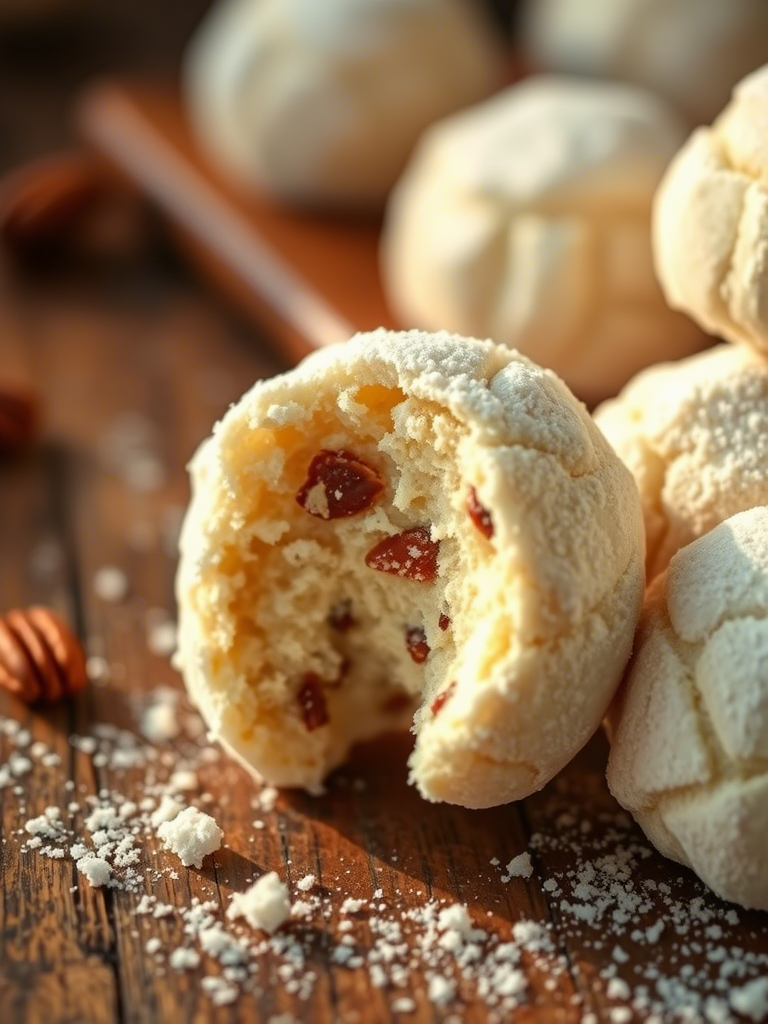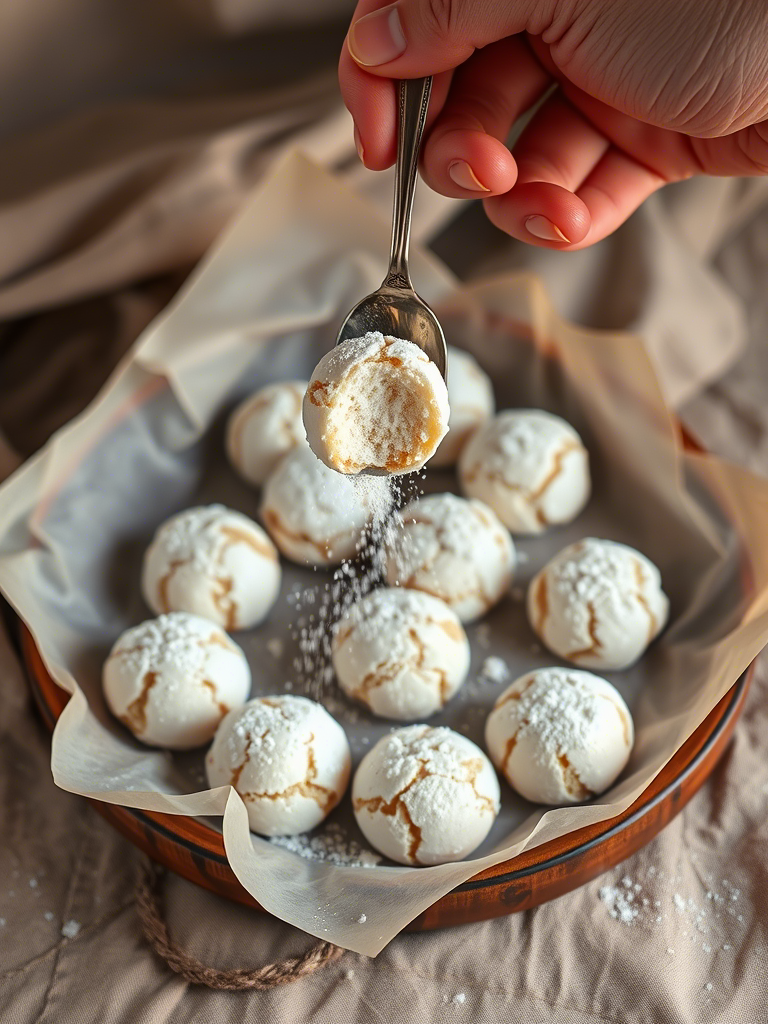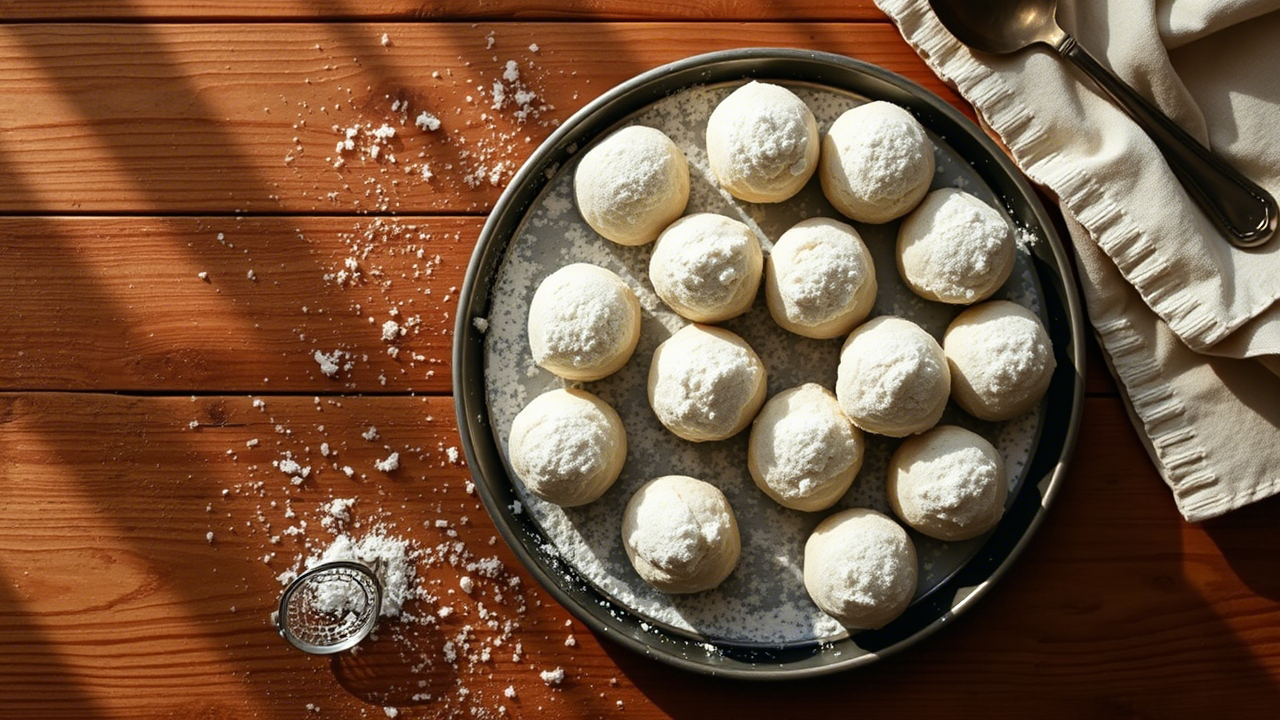Let’s be honest right from the first crumb—snowball cookies don’t just taste good. They disappear. Fast. Every time. It’s like they were never there. Buttery, nutty, sweet little globes that shatter and melt in the mouth faster than you can say, “Hey, who ate the last one?”
And if you’re thinking, they’re just cookies, you’re missing the point. Snowball cookies, also known by names like Mexican wedding cookies, Russian tea cakes, and butterballs, are steeped in tradition, precision, and a whole lotta love (and science). For pastry professionals, they offer a masterclass in texture control, fat chemistry, and heat balance—all packed in a deceptively humble bite.
This ain’t just another cookie recipe. This is an edible architecture lesson.
What Exactly Are Snowball Cookies?
They’re rich, round shortbread-style cookies, usually made with butter, flour, finely chopped nuts (often pecans or walnuts), and powdered sugar—both inside and out.
No eggs.
No leavening agents.
No frills. Just fat, flour, and nutty finesse.
What sets them apart is their delicate crumb, which walks a tightrope between sandy and tender. Too much flour, and you’re chewing sawdust. Not enough, and the cookie puddles into a greasy mess.
Think of it like sculpting snow. Too wet, it slumps. Too dry, it won’t hold.
The Science Behind That Signature Texture
Here’s where it gets wild. Snowball cookies are almost entirely fat-based. The butter—preferably high-fat European-style butter—carries the whole operation. It coats the flour proteins, limiting gluten formation, and creating that ultra-short crumb.
When baked, the cookie doesn’t spread much (no egg, no leaveners, remember?), and the result is this dome-shaped delight that crumbles on contact. The nuts add just enough bite and earthy warmth to break up the richness.
Butter’s water content (usually around 15–18%) also steams gently inside, helping keep the interiors slightly moist. That is—if you didn’t overbake ’em.
A 2021 food science study from the University of Wisconsin even confirmed that nut particle size affects moisture retention and perceived texture in high-fat cookies. Finer grind = tighter crumb, coarser chop = more crunch. So yes, even how you chop your nuts changes the end result.

A Little Cookie With Many Names and Stories
Snowball cookies didn’t fall from the sky. Their roots twist through culinary history like creeping thyme in an old herb garden.
In Mexico, they’re “Polvorones,” named after their powdery nature. They’re also popular during weddings—thus “Mexican wedding cookies.” Russia claims them too. So do the Southern states of the U.S., where pecan sandies and butterballs reign at holiday gatherings.
In Arabic cuisines, similar cookies called ghraybeh are baked for Eid celebrations. In Greece, they call ‘em kourabiedes, shaped a bit differently but built from the same buttery bones.
Same cookie. Dozens of names. Dozens of cultures. That’s the beauty of food—it travels better than any suitcase.
Ingredient Quality Matters More Than Ever
Here’s where professionals know not to compromise: ingredients. Snowball cookies are simple, yes. But that’s the danger. There’s nothing to hide behind. If your butter’s off, if your flour is weak, if your nuts are stale—you’ll taste every bit of that sadness.
Key Ingredients, Expert Style:
- Butter: Go European. Aim for 82%+ butterfat. Kerrygold or Plugrá are solid choices. The extra fat lends richness without leaking.
- Flour: Use low-protein all-purpose or a mix of AP + cake flour (70/30 ratio) if you want extra tenderness.
- Nuts: Toast ‘em first. Always. Even a 6-minute roast at 325°F can coax out deep aromatic oils. Pecans are traditional, but almonds or pistachios shine too.
- Powdered sugar: Sifted. Twice. No lumps, no drama.
- Salt: Just a pinch. It sharpens the flavor of both the butter and nuts.
And if you’re gluten-free, you ain’t outta luck. Many pros are now subbing in almond flour or a rice flour blend with great results. A 2022 trend survey from the American Culinary Federation showed a 32% uptick in gluten-free holiday baked goods demand—snowballs are prime territory for that shift.
Mixing Techniques: You Can’t Rush the Dough
Don’t cream the butter like you’re making cupcakes. Snowball dough demands restraint. You’re not looking for air—you’re looking for cohesion.
- Room temp butter. Not melted. Not cold. Soft like the inside of your palm.
- No overmixing. Just enough for the dough to hold together. Overbeat and you’ll develop too much structure, and your cookies might puff or crack.
- Rest the dough. At least 30 minutes in the fridge. Overnight’s better. It hydrates the flour and firms the fat, reducing spread.
Chefs at Le Cordon Bleu in Paris actually teach this technique as part of their foundational cookie modules—it’s that important.
Baking Like a Boss
Bake these babies low and slow. 325°F is the sweet spot. Higher temps brown the bottoms too quick and rob the interior of tenderness.
Roll ‘em into balls about 1 inch in diameter. Uniformity matters—uneven size leads to uneven bake. A cookie scoop is your best pal here.
Bake for 15–18 minutes, until the bottoms just show golden edges. You don’t want full browning; these aren’t shortbread cookies. They should look like they’re blushing.

Double Dusted: The Art of the Powdered Sugar Blanket
Now here’s a crucial step that many mess up. The double-dusting.
First coat happens while the cookies are still warm, almost too hot to handle. The sugar clings better, melts slightly, and forms a sweet sticky shell.
Second coat? After they’ve cooled completely. That’s when you get that classic snowball finish—powdery, soft, matte-white glory. Looks like they rolled straight outta the Alps.
Use a wide shallow bowl, and don’t be stingy. Powdered sugar gets everywhere. Accept your fate.
Storage and Shelf Life: Butter’s Built-In Preservative
Here’s a sneaky benefit: these cookies age like fine wine.
Stored in an airtight tin at cool room temp, they’ll stay fresh for 2 weeks. That’s thanks to the high fat content and lack of moisture-attracting ingredients (like eggs).
In fact, most bakers agree they taste better a day or two after baking. The flavors meld. The sugar softens. The texture hits peak meltiness.
Pro tip: Freeze unbaked dough balls and bake fresh as needed. They’ll last up to 3 months in the freezer, and you can go oven-to-cookie in under 20 minutes.
Troubleshooting Like a Pro
Cookies spreading too much?
→ Dough too warm. Or you overmixed. Chill longer next time.
Dry, chalky texture?
→ Too much flour. Or your nuts weren’t finely chopped.
Powdered sugar won’t stick?
→ Cookies cooled too much before first roll. Rewarm gently and try again.
Bitter flavor?
→ Old nuts or over-roasted. Always taste your ingredients before committing.
Even seasoned pastry chefs mess these up now and then. Consistency comes from precision, not speed.
Trends, Twists, and Flavors to Watch
In 2025, snowball cookies are getting creative spotlights like never before.
- Matcha snowballs are huge in Tokyo patisseries right now.
- Lavender-lemon versions are popping up on West Coast menus, offering a floral spin on the classic.
- Pumpkin spice versions sell out by the dozen at farmers markets from Vermont to Oregon.
- And don’t sleep on hazelnut-cocoa snowballs—Nutella fans go wild for ‘em.
According to Pinterest Predicts 2025, searches for “holiday cookie box ideas” rose by 67% in Q4 2024. Snowballs are nearly always featured, especially because they travel well and don’t crumble like drop cookies.
Chefs are even dusting them in colored powdered sugars now—red beet, matcha green, turmeric-gold. It’s kitschy, sure. But it sells.
Final Thoughts: The Small Cookie That Teaches Big Lessons
If you think snowball cookies are easy, you’ve probably never tried baking them for a crowd. Precision is everything. Ingredient quality is non-negotiable. And technique? More important than most folks realize.
But get it right, and these simple, snowy rounds will carry your baking reputation to ridiculous heights. Like, “Are you bringing your snowballs this year?” levels of fame.
So toast your nuts. Weigh your flour. Rest your dough.
And don’t forget that second sugar roll.
Because the best snowball cookies? They don’t crunch. They whisper. Then vanish.
FAQs
What are snowball cookies made of?
Snowball cookies are made with butter, flour, finely chopped nuts, and powdered sugar—no eggs or leavening agents.
Why do snowball cookies crumble so easily?
Their high butter content and low moisture create a delicate, tender texture that crumbles in the mouth.
Can I use different nuts in snowball cookies?
Yes, pecans, walnuts, almonds, hazelnuts, and even pistachios work well depending on your flavor preference.
Why do I need to double-coat the cookies in powdered sugar?
The first coat melts slightly to stick; the second creates that classic snowy look and sweet finish.
Can I make snowball cookies gluten-free?
Absolutely—almond flour or gluten-free flour blends work beautifully in place of regular flour.
How long do snowball cookies stay fresh?
Stored in an airtight container, they stay fresh for up to 2 weeks and even improve after a day or two.
Can I freeze snowball cookie dough?
Yes, freeze unbaked dough balls for up to 3 months and bake directly from frozen when needed.
Why did my snowball cookies flatten in the oven?
The dough was likely too warm or overmixed—chill it longer next time before baking.
What butter is best for snowball cookies?
Use high-fat European-style butter like Kerrygold or Plugrá for the richest flavor and best texture.
Are snowball cookies the same as Mexican wedding cookies?
Yes, they’re essentially the same cookie but go by different names in different cultures.

Mariana is a passionate home cook who creates delicious, easy-to-follow recipes for busy people. From energizing breakfasts to satisfying dinners and indulgent desserts, her dishes are designed to fuel both your body and hustle.
When she’s not in the kitchen, she’s exploring new flavors and dreaming up her next recipe to share with the Foodie Hustle community.

